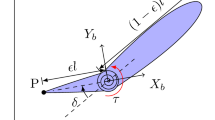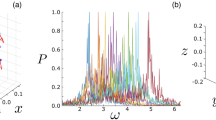Abstract
This paper outlines a methodology for the construction of vector fields that can enable a multi-robot system moving on the plane to generate multiple dynamical behaviors by adjusting a single scalar parameter. This parameter essentially triggers a Hopf bifurcation in an underlying time-varying dynamical system that steers a robotic swarm. This way, the swarm can exhibit a variety of behaviors that arise from the same set of continuous differential equations. Other approaches to bifurcation-based swarm coordination rely on agent interaction which cannot be realized if the swarm members cannot sense or communicate with one another. The contribution of this paper is to offer an alternative method for steering minimally instrumented multi-robot collectives with a control strategy that can realize a multitude of dynamical behaviors without switching their constituent equations. Through this approach, analytical solutions for the bifurcation parameter are provided, even for more complex cases that are described in the literature, along with the process to apply this theory in a multi-agent setup. The theoretical predictions are confirmed via simulation and experimental results with the latter also demonstrating real-world applicability.
Similar content being viewed by others
Code or Data Availability
Not applicable.
References
Das, S., Hunter, E.E., DeLateur, N.A., Steager, E.B., Weiss, R., Kumar, V.: Cellular expression through morphogen delivery by light activated magnetic microrobots. J. Micro-Bio. Robot. 15(2), 79–90 (2019)
Kokkoni, E., Mavroudi, E., Zehfroosh, A., Galloway, J.C., Vidal, R., Heinz, J., Tanner, H.G.: GEARing smart environments for pediatric motor rehabilitation. J. Neuroeng. Rehabil. 17(1), 16 (2020)
Kokkoni, E., Zehfroosh, A., Kannappan, P., Mavroudi, E., Galloway, J.C., Heinz, J., Vidaly, R., Tanner, H.G.: Principles for building “smart” learning environments in pediatric early rehabilitation. Robot.: Sci. Sys.; Workshop Percept. Interact. Dyn. Child-Robot Interact. (2017)
Zehfroosh, A., Tanner, H.G.: Reactive Motion Planning for Temporal Logic Tasks Without Workspace Discretization. In: Proceedings of the IEEE American Control Conference, pp. 4872–4877 (2019)
Tanner, H., Christodoulakis, D.: Cooperation Between Aerial and Ground Vehicle Groups for Reconnaissance Missions. In: Proceedings of the IEEE Conference on Decision and Control, pp. 5918–5923 (2006)
Valbuena Reyes, L.A., Tanner, H.G.: Flocking, formation control, and path following for a group of mobile robots. IEEE Trans. Control. Syst. Technol. 23(4), 1268–1282 (2015)
Yadav, I., Tanner, H.G.: Mobile Radiation Source Interception by Aerial Robot Swarms. In: Proceedings of the 2nd IEEE International Symposium on Multi-Robot and Multi-Agent Systems, pp. 63–69 (2019)
Marshall, J.A., Broucke, M.E., Francis, B.A.: Formations of vehicles in cyclic pursuit. IEEE Trans. Autom. Control 49(11), 1963–1974 (2004)
Halder, U., Schlotfeldt, B., Krishnaprasad, P.: Steering for beacon pursuit under limited sensing. In: Proceedings of the IEEE 55th Conference on Decision and Control, pp. 3848–3855 (2016)
Galloway, K.S., Dey, B.: Collective motion under beacon-referenced cyclic pursuit. Automatica 91, 17–26 (2018)
Gazi, V.: Swarm aggregations using artificial potentials and sliding-mode control. IEEE Trans. Robot. 21(6), 1208–1214 (2005)
Topaz, C.M., Bertozzi, A.L.: Swarming patterns in a two-dimensional kinematic model for biological groups. SIAM J. Appl. Math. 65(1), 152–174 (2004)
Virágh, C., Vásárhelyi, G., Tarcai, N., Szörényi, T., Somorjai, G., Nepusz, T., Vicsek, T.: Flocking algorithm for autonomous flying robots. Bioins. Biomim. 9(2), 025012 (2014)
Edwards, V., deZonia, P., Hsieh, M.A., Hindes, J., Triandaf, I., Schwartz, I.B.: Delay induced swarm pattern bifurcations in mixed reality experiments. Chaos Interdiscip. J. Nonlinear Sci. 30(7), 073126 (2020)
Szwaykowska, K., Schwartz, I.B., Romero, L.M.-y-T., Heckman, C.R., Mox, D., Hsieh, M.A.: Collective motion patterns of swarms with delay coupling: Theory and experiment. Phys. Rev. E 93(3), 032307 (2016)
Schwartz, I.B., Edwards, V., Kamimoto, S., Kasraie, K., Ani Hsieh, M., Triandaf, I., Hindes, J.: Torus bifurcations of large-scale swarms having range dependent communication delay. Chaos Interdiscip. J. Nonlinear Sci. 30(5), 051106 (2020)
Tanner, H.G., Loizou, S., Kyriakopoulos, K.J.: Nonholonomic navigation and control of cooperating mobile manipulators. IEEE Trans. Robot. Autom. 19(1), 53–64 (2003)
Tanner, H.G., Jadbabaie, A., Pappas, G.J.: Stable Flocking of Mobile Agents, Part I: Fixed Topology. In: Proceedings of the IEEE Conference on Decision and Control, pp. 2010–2015 (2003)
Tanner, H.G., Jadbabaie, A., Pappas, G.J.: Stable Flocking of Mobile Agents, Part II: Dynamic Topology. In: Proceedings of the IEEE Conference on Decision and Control, pp. 2016–2021 (2003)
Saber, R.O.: Flocking for multi-agent dynamic systems: algorithms and theory. IEEE Trans Autom Control 51(3), 401–420 (2007)
Stager, A., Tanner, H.: Composition of Local Potential Functions with Reflection. In: Proceedings of the IEEE International Conference on Robotics and Automation, pp. 5558–5564 (2019)
Panagou, D., Tanner, H.G., Kyriakopoulos, K.J.: Nonholonomic control design via reference vector fields and output regulation. ASME J. Dyn. Sys. Meas. Control 137(8), 2831–2836 (2015)
Kingston, P., Egerstedt, M.: Index-free multi-agent systems: An eulerian approach. IFAC Proc. 43(19), 215–220 (2010)
Panagou, D., Tanner, H.G., Kyriakopoulos, K.J.: Control of nonholonomic systems using reference vector fields. In: 2011 50th IEEE Conference on Decision and Control and European Control Conference, pp. 2831–2836 (2011)
Stager, A., Tanner, H.G.: Stochastic Behavior of Robots that Navigate by Interacting with Their Environment. In: Proceedings of the IEEE Conference on Decision and Control, pp. 6871–6876 (2016)
Karydis, K., Zarouk, D., Poulakakis, I., Fearing, R.S., Tanner, H.G.: Planning with the Star(s). In: Proceedings of the IEEE/RSJ International Conference on Intelligent Robots and Systems, pp. 3033–3038 (2014)
Goebel, R., Sanfelice, R.G., Teel, A.R.: Hybrid Dynamical Systems. In: Princeton University Press (2012)
Reverdy, P.B.: A route to limit cycles via unfolding the pitchfork with feedback. In: Proceedings of the American Control Conference, pp. 3057–3062 (2019)
Reverdy, P.B., Koditschek, D.E.: A dynamical system for prioritizing and coordinating motivations. SIAM J. Appl. Dyn. Sys. 17, 1683–1715 (2018)
Thompson, C., Reverdy, P.B.: Drive-based motivation for coordination of limit cycle behaviors. In: Proceedings of the IEEE Conference on Decision and Control (CDC), pp. 244–249 (2019)
Baxevani, K., Tanner, H.G.: Multi-behavioral multi-robot systems driven by motivation dynamics. In: Proceedings of the American Control Conference, (in Print) (2023)
Baxevani, K., Tanner, H.G.: Bifurcating vector fields driven by time-scale separated motivational dynamics. In: Proceedings of the IFAC World Congress, (in Print) (2023)
Guckenheimer, J., Holmes, P.: Nonlinear Oscilations, Dynamical Systems, and Bifurcation of Vector Fields. In: Springer-Verlag (1983)
Verduzco, F.: The First Lyapunov Coefficient for a Class of Systems. In: Triennial IFAC World Congress, pp. 1205–1209 (2005)
Valbuena, L.R., Tanner, H.G.: Flocking, formation control and path following for a group of mobile robots. IEEE Trans. Control. Syst. Technol. 23(4), 1268–1282 (2015)
d’Andréa-Novel, B., Bastin, G., Campion, G.: Modelling and Control of Non Holonomic Wheeled Mobile Robots. In: Proceedings of the 1991 IEEE International Conference on Robotics and Automation, pp. 1130–1135 (1991)
Baxevani, K., Tanner, H.G.: Constructing continuous multi-behavioral planar systems through motivation dynamics and bifurcations. In: Proceedings of the IEEE Conference on Decision and Control, pp. 1095–1100 (2021)
Baxevani, K., Otto, G.E., Tanner, H.G., , Trembanis, A.C.: Development and Field Testing of an Optimal Path Following ASV Controller for Marine Surveys. In: Proceedings of the 2022 IEEE/RSJ International Conference on Intelligent Robots and Systems, pp. 6861–6866 (2022)
OpenCV Developers Team: Open Source Computer Vision (OpenCV) Library. Available: http://opencv.org. Accessed 2000
Loizou, S.G.: The navigation transformation. IEEE Trans. Robot. 33(6), 1516–1523 (2017)
Acknowledgements
This work is supported by the National Science foundation’s Smart and Connected Health program via award # 2014264.
Funding
This work is supported by the National Science foundation’s Smart and Connected Health program via award # 2014264.
Author information
Authors and Affiliations
Contributions
All authors contributed to the study conception and design. Material preparation, data collection and analysis were performed by Kleio Baxevani and Herbert Tanner. The first draft of the manuscript was written by Kleio Baxevani and all authors commented and edited the manuscript. All authors read and approved the final manuscript.
Corresponding author
Ethics declarations
Ethics approval
This work did not involve human or animal subjects therefore it did not require ethics approval.
Consent to participate
Not applicable.
Consent for publication
Not applicable.
Conflicts of Interest
The authors have no relevant financial or non-financial interests to disclose.
Additional information
Publisher's Note
Springer Nature remains neutral with regard to jurisdictional claims in published maps and institutional affiliations.
Rights and permissions
Springer Nature or its licensor (e.g. a society or other partner) holds exclusive rights to this article under a publishing agreement with the author(s) or other rightsholder(s); author self-archiving of the accepted manuscript version of this article is solely governed by the terms of such publishing agreement and applicable law.
About this article
Cite this article
Baxevani, K., Tanner, H.G. Multi-modal Swarm Coordination via Hopf Bifurcations. J Intell Robot Syst 109, 34 (2023). https://doi.org/10.1007/s10846-023-01966-4
Received:
Accepted:
Published:
DOI: https://doi.org/10.1007/s10846-023-01966-4




